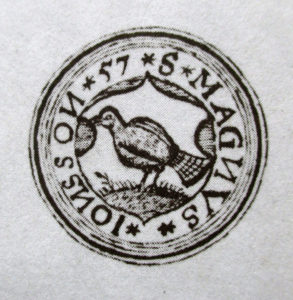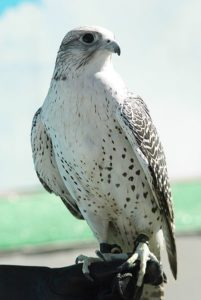Newspaper article: Reger Handel mit dem hohen Norden
Bart Holterman, 7 September 2017
Bart Holterman presentated the project and his own research on August 5 in Haus der Wissenschaft in Bremen. Matthias Holthaus was there as well and wrote the following article about it in the Weser Kurier of August 21, which gives a nice overview of the situation German merchants had to deal with when trading in the North Atlantic in the late Middle Ages (in German).
Posted in: Press
Worth a fortune: Icelandic gyrfalcons
Natascha Mehler, 11 August 2016
Throughout the medieval and early modern period, Icelandic gyrfalcons were highly valued at the courts of European rulers and they were worth a fortune. Indeed, Frederick II (1194-1250), Holy Roman Emperor, already noted in his treatise De arte venandi cum avibus that the best falcons for use in falconry were gyrfalcons (…et isti sunt meliores omnibus aliis, Girofalco enim dicitur). The reason for this was that of all falcon species, gyrfalcons (Falco rusticolus) are the largest and most powerful. Their plumage varies greatly from completely white to very dark, of which the white variety was the most valued hawking bird in the Middle Ages, and still is today. They only inhabit sub-arctic and arctic areas, with their highest population density in Iceland (one pair per 150-300 km²). During the breeding season (roughly February to June) there are today 200-400 nesting pairs in Iceland, and in the winter the population increases to 1.000-2.5000 individuals, due to migrating birds from Greenland.
Written sources from the 16th century, when German merchants from Hamburg and Bremen dominated the trade with the North Atlantic islands, give us a better insight into the falcon business with Iceland. Matthias Hoep, a Hamburg merchant, has left behind a collection of account books (1582-1594) which show us that he traded in many commodities such as fish, timber, and tools, and specialized in the trade of falcons. Hoep employed falcon catchers to catch birds in Iceland for him and he made specific contracts with them. The books record a great number of falcons and other birds of prey that he bought from falcon catchers and which he then sold on. On 5 April 1584, Hoep made a contract with the falcon catchers and brothers Augustin and Marcus Mumme which he commissioned to travel to Iceland to catch falcons. The contract specified the bird species, the conditions of the birds upon delivery, and the prices Hoep was going to pay after the successful return of the Mummes from Iceland:
“On 5 April [1584] I have dealt in my house with Augustin and Marcus Mumme, in the name of god, that they shall sail to Iceland in the name of god, and we agreed that I will give for each pair of falcons 11 ½ daler, and 2 tercel [male falcons] for 1 falcon, and what is blank shall be counted as a red [unmoulted] falcon. But what is white and moulted once, or moulted twice and beautiful, for those I shall give them 20 daler for each falcon and 10 daler for a tercel. But what has moulted three times we shall agree upon with good will, and if god and luck provides them with white falcons, I will give the one who catches them black cloth for a jacket of 2 ½ ells, all of this is validated with a denarius dei of 1 sosling each, and both brothers have promised with an oath to bring the best birds they can get and to take no birds away, neither in Iceland nor during the journey back, until they have all been delivered to me.“
Roughly five months later, in September 1584, the brothers returned from Iceland and handed over 49 birds to Matthias Hoep.

Detail of the Carta Marina (1539) showing the coat of arms of Iceland (stockfish), with a gyrfalcon (FALCO ALBI) above.
Later documents tell us how the shipping of the falcons was done. During the 17th century, a Danish falcon ship went to Iceland annually to transport falcons from Iceland to Copenhagen. The falcons were kept below the deck and sat on poles which were lined with vaðmál. During the journey, the birds were fed with meat of cattle, sheep or birds, dipped in milk, and when they were sick, they were fed with a mix of eggs and (fish) oil. Upon arrival of the birds in Hamburg, Mathias Hoep checked their health and quality and he considered them in good state after they had eaten three times and their feathers were not broken.
Most of the birds that Hoep received were sold to English merchants such as John Mysken who bought 55 birds of prey in 1584 and had them shipped to England, most likely to be sold to the English court. It is likely that Hoep also had good contacts with Icelanders, both in Iceland and in Hamburg. His professional network may have included Magnús Jónsson (c. 1530-1591), who had studied law in Hamburg, probably until 1556. In Iceland he became chieftain and sýslumaður (sheriff) at Þingeyjaþingssýsla and Ísafjarðarsýsla, districts in the North of Iceland with a very high density of falcons. No wonder his seal from the year 1557 shows a gyrfalcon in the centre.

Seal of Magnús Jónsson, dated 1557. The priest Ólafur Halldórsson, a contemporary of Magnús Jónsson, described the seal in a poem: „Færði hann í feldi blá, fálkann hvíta skildi á, hver mann af því hugsa má, hans muni ekki ættin smá.” (transl. „he carried in a blue field, a white falcon on his shield, so that everybody shall think his family is not insignificant“).
In the second half of the 16th century, king Frederick II of Denmark-Norway (1559-1588) started to regulate the export of falcons to foreign countries. From the 1560s onwards, foreign falcon catchers needed to buy a permission (Icel. fálkabréf, falcon letter) to catch falcons.
Were falcons also caught in Shetland or the Faroes?
We have not found any written evidence for that. The obvious reason for this is that there are not many falcons around in Shetland and the Faroes. Gyrfalcons only appear as vagrant birds, and peregrine falcons (Falco peregrinus) exist in Shetland only in small numbers. However, it is worth pointing out that in the years 1601 to 1606 one Tonnies Mumme is recorded to have sailed each summer from Hamburg to Shetland. We do not know whether this is the same Tonnies Mumme that is reported as falcon catcher in Iceland in previous years, or whether Tonnies is related to the Augustin and Marcus Mumme mentioned above, but it seems very likely. He may have tried his luck in Shetland, or might have changed his profession and have traded in other items.
Further reading
Natascha Mehler, Hans Christian Küchelmann & Bart Holterman, The export of gyrfalcons from Iceland during the 16th century: a boundless business in a proto-globalized world. In: Gersmann, Karl-Heinz & Grimm, Oliver (eds.): Raptor and human – falconry and bird symbolism throughout the millennia on a global scale, vol. 3, Advanced studies on the archaeology and history of hunting 1 (Neumünster 2018), 995-1019.
Kurt Piper, Der Greifvogelhandel des Hamburger Kaufmanns Matthias Hoep (1582-1594). Jahrbuch des Deutschen Falkenordens (2001/2002), 205-212.
Björn Þórðarson, Íslenzkir fálkar. Safn til sögu Íslands og íslenskra bókmennta (Reykjavík 1957).
Posted in: Stories
